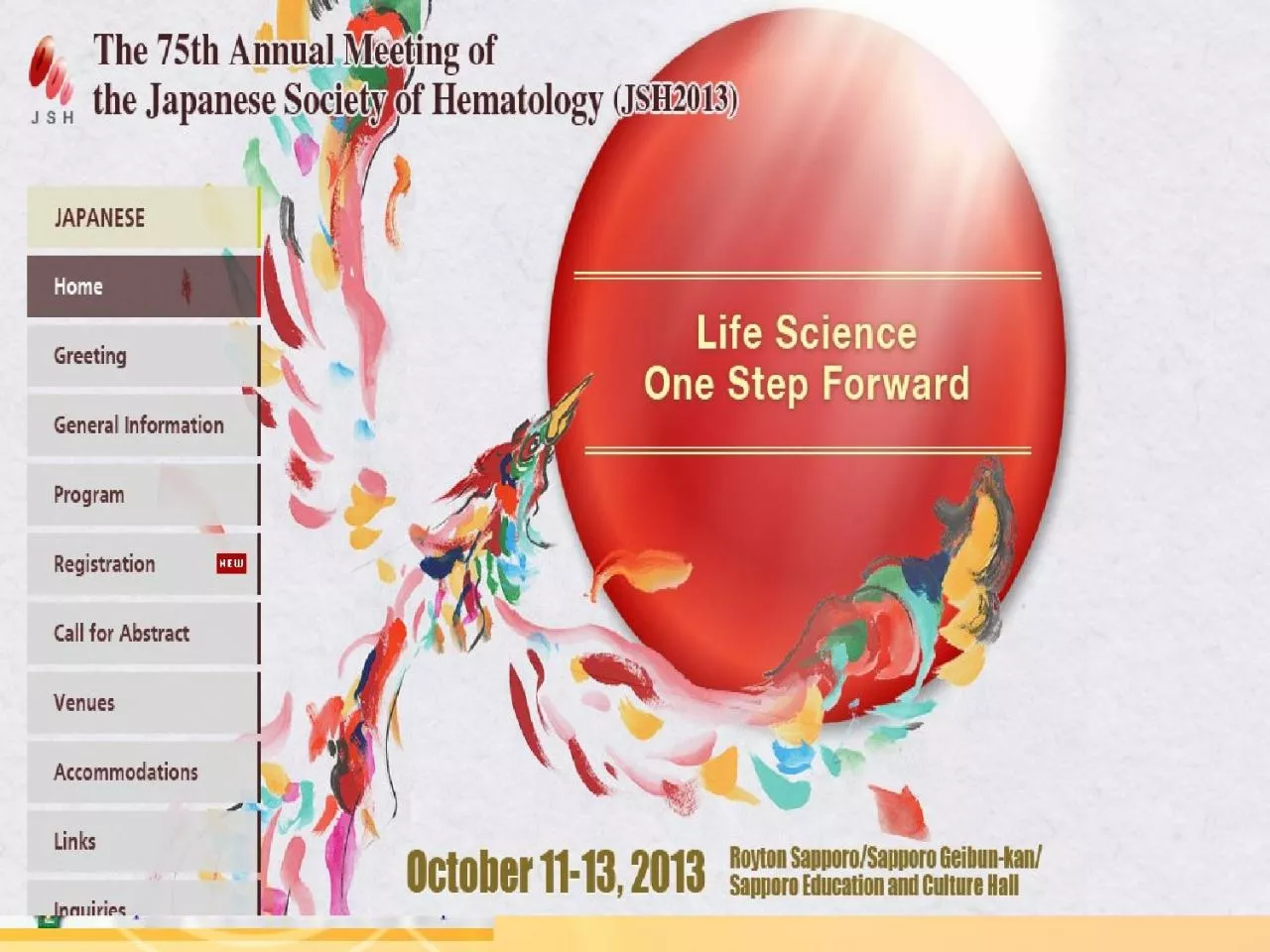

the single institute experience in Taiwan Sheng HsuanChien MD Division of Hematology and Oncology Department of medicine Taipei Veteran General Hospital National YangMing University School of medicine Taipei Taiwan ID: 1036328
Download Presentation The PPT/PDF document "1 DLBCL of the elderly in age older th..." is the property of its rightful owner. Permission is granted to download and print the materials on this web site for personal, non-commercial use only, and to display it on your personal computer provided you do not modify the materials and that you retain all copyright notices contained in the materials. By downloading content from our website, you accept the terms of this agreement.
1. 1
2. DLBCL of the elderly in age older than life expectancy the single institute experience in Taiwan Sheng Hsuan,Chien, MD Division of Hematology and Oncology,Department of medicine, Taipei Veteran General HospitalNational Yang-Ming University School of medicine, Taipei, Taiwan 2
3. Life expectancy in Taiwan 32002 2003 2004 2005 2006 2007 2008 2009 2010 2011 2012Years- old Life expectancy in Taiwan from 2002-2012FemaleMaleAll Statistics Department, Ministry of The Inferior, Taiwan, 2013
4. Age over 60 in Japan4World Health Organization, Global Health Observatory repository
5. 5Statistics and Information DepartmentMinister's SecretariatMinistry of Health, Labour and WelfareJAPAN
6. 6Cancer. 2007 Aug 15;110(4):896-905.
7. Top 10 cancer in 2009, Taiwan 7
8. Age in 60-80 years-old 8Groupe d’Etude des Lymphomes de l’Adulte study in patients 60 to 80 years old N Engl J Med, Vol. 346, No. 4
9. Difficult in treating very elderly (age ≥ 80yrs) NHLMultiple co-morbid illness Decreased portal/renal perfusion flow Altered pharmacokineticsDecreased bone marrow hematopioetic reserve Poor compliance and tolerance Exclude in clinical trial, no available guideline9Westin EH ,et al . Semin Oncol 2004; 31: 198–205.
10. Aims of studyClinical and laboratory features of very elderly patients with DLBCL in TaiwanTreatments, responses and Toxicities Prognostic factors Survival analysis 10
11. Patients and methods Newly diagnosed DLBCL, NOS in Taipei Veteran General Hospital Age ≧80 years old, from 2000 to 2012Parameters collected at diagnosis: ECOG PS, Ann Arbor stage, LDH, WBC, Hb, albumin, LVEF, aaIPI score Comorbidities record as Charlson score 11
12. Patients and methods Immuno-chemotherapyRituximab or Anthracycline contained or not 5 common regimens: R only, COP, CHOP, R-COP, R-CHOP Definition of treatment competenceIntent to treatment (ITT): received any systemic chemotherapy Early treatment failure (ETF): treatment < 3 cycles Per-protocol treatment (PPT): treatment ≥ 3 cycles Receiving Immuno-Chemotherapy cycle versus patient subgroups 12
13. Patients and methods Response according to International Workshop of response criteria for NHL established in 1999Toxicities according to NCI CTC (version 3.0)Statistical analysis Chi-square test for categorical variableKaplan-Meier method for survival and curves compared using log-rankCox-regression for multivarite anaylsisReceiving Immuno-Chemotherapy cycle versus patient groups 13
14. Results 14
15. Result 183 patients in single was conducted in in Taipei Veteran General HospitalMedian age: 84.2 years old 67% of patients had high age-adjusted International Prognostic Index (≥2)33 % of patents had high Charlson comorbidity Index scores (>8)15
16. Characteristics in morbidities 16High proportion in high Charlson score(>9)Congestive heart failureCerebrovascular accidentChronic obstructive pulmonary disease Ulcer Liver disease Diabetic mellitus Any tumor
17. Treatment subgroups 17* Included operation only (2) and radiation only (3)
18. Survival in each group 18Media survival14.2 months10.3 months7.7 months
19. Characteristics in No treatment VS Intent to treatment 19High proportion in No Treatment groupDiagnosis before 2004PS, ECOG> 1 Hypoalbuminemia
20. Characteristic in early treatment faiulre VS per-protocol treatment 20High proportion in early Treatment failure PS, ECOG>1aaIPI:2-3Extra-nodal involved > 2Anemia < 12 Marrow involved Less R contained therapy
21. Early treatment failures21Death(18)82%Toxicities(4)18%
22. 22
23. 23ORR:72%OCR: 39 %
24. Prognostic facotr in all patients24Significant prognostic factor in multivariate analysis:aaIPI:2-3Hb<12Marrow involement No treatment For all patients
25. Prognostic factor in ITT 25For intent to treatment Significant prognostic factor in multivariate analysis:aaIPI:2-3Hb<12Marrow involvement Rituximab or Anthracycline contained therapy used ≧ 2 cycles
26. 26≥<
27. 27≥<
28. Prognostic factor in PPT28For per-protocol treatment Significant prognostic factor in multivariate analysis:Charlson score index >8No complete response
29. 29
30. Discussion/conclusion 15% of very elderly DLBCL patients DID NOT receive immuno-chemotherapy and 28% of intent-to-treat patients (i.e., 24% of all patients) had early treatment failure (ETF). Treatment-related toxicities account for the most cases with ETF(52%). For ‘very elderly’ DLBCL patients, aaIPI, marrow involvement , Hb level at diagnosis, and treatment or not play important roles in the prognosis30
31. Conclusion/DiscussionFor ‘intent to treatment’ patients, administration ≥ 2 cycles of Rituximab or ≥ 2 cycles of anthracycline containing chemotherapy are associated with a better overall survival .To improve the prognosis of these frail patients, the initiation of the prospective study to determine appropriate cycles of rituximab and anthracycline is highlighted. 31
32. The limitation of our study Retrospective analysis: additional efforts to collect the information aboutDose reduction of chemotherapeutic agents, especially for anthracyclineInter-cycle delay Initiation of G-CSF use following chemotherapy and prophylaxis of infection varies and was dependent on the physicians in chargeUpdated geriatric assessment: not available The reasons for the final decision of not-to-treat by the patients and family 32
33. 33Thank You
34. Acknowledgement Taipei Veteran General Hospital, TaiwanDepartment of Medicine, Division of Hematology and OncologyLiang-Tsai Hsiao, Yuan-Bin Yu, Chun-Yu Liu, Jyh-Pyng Gau, Jin-Hwang Liu, Po-Min Chen, Cheng-Hwai TzengDivision of Transfusion Medicine,Tzeon-Jye Chiou,Department of Pathology and Laboratory MedicineChing-Fen Yang 34